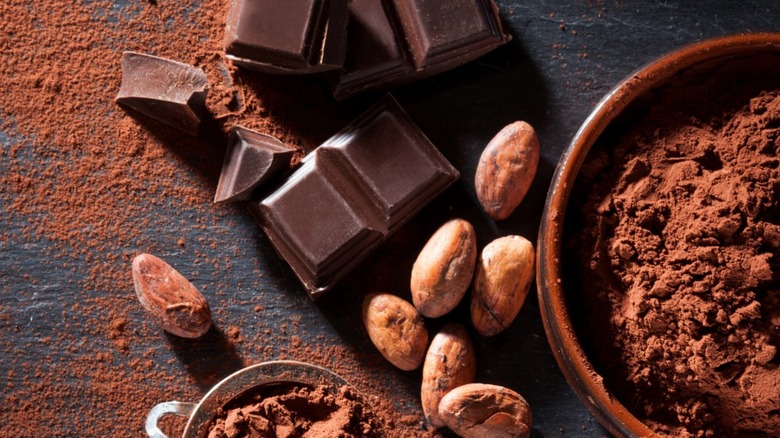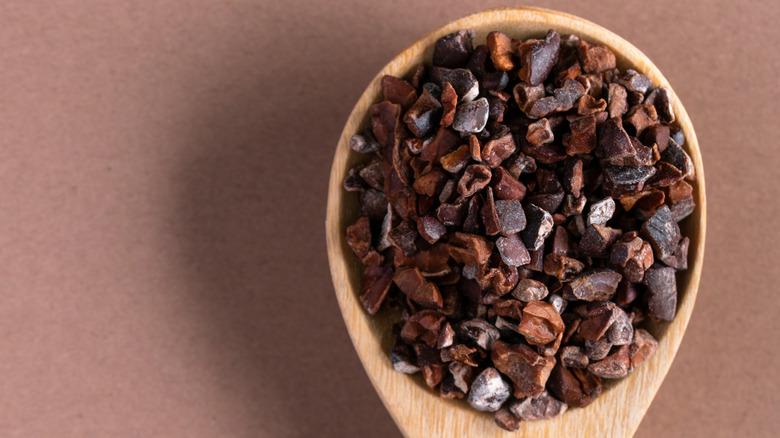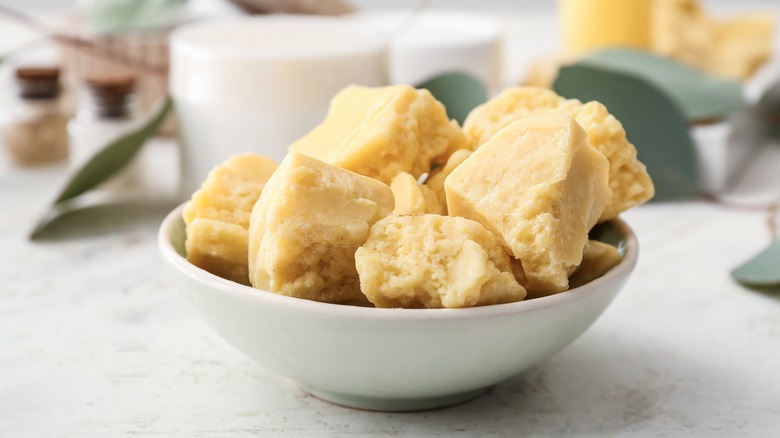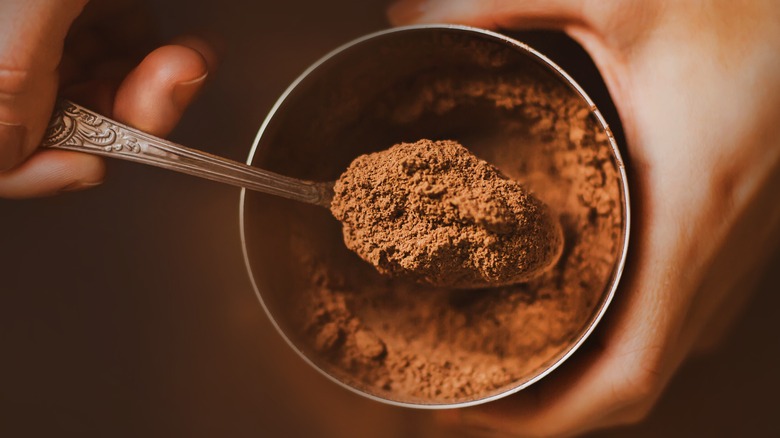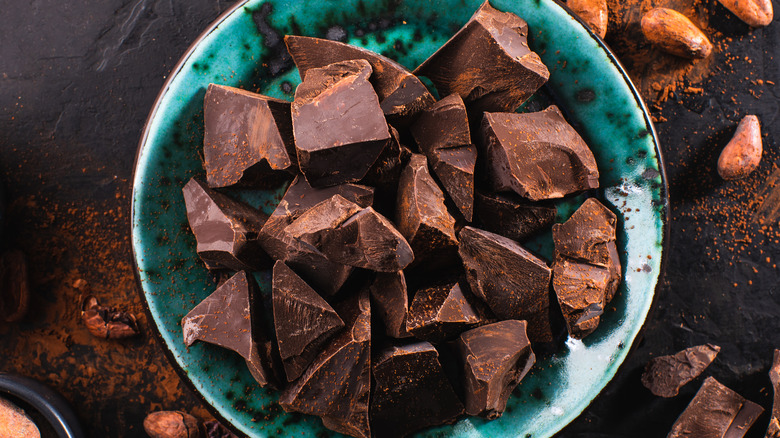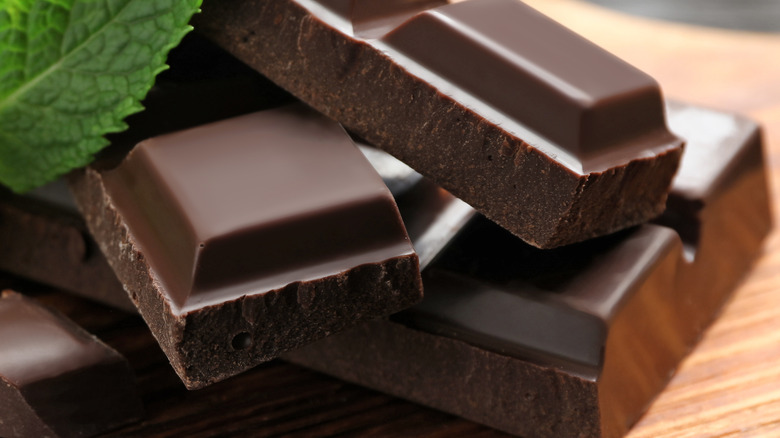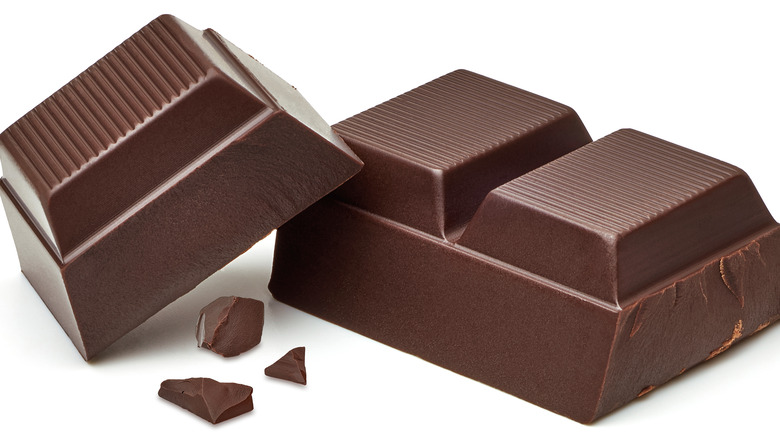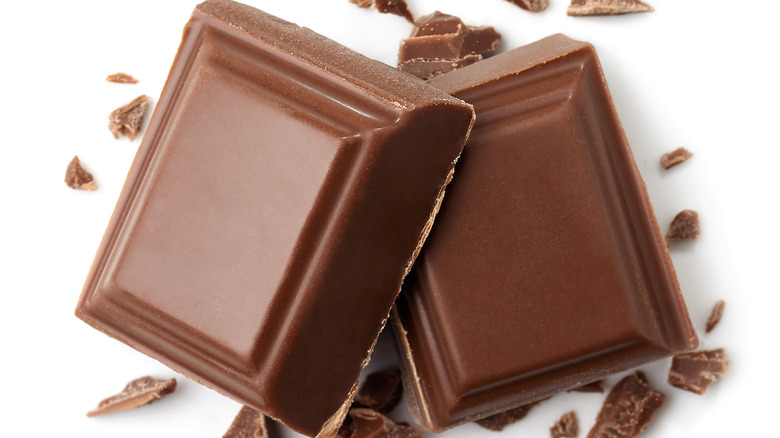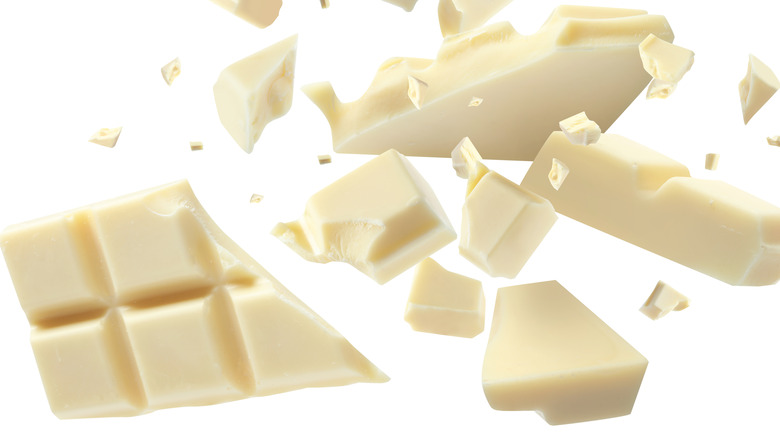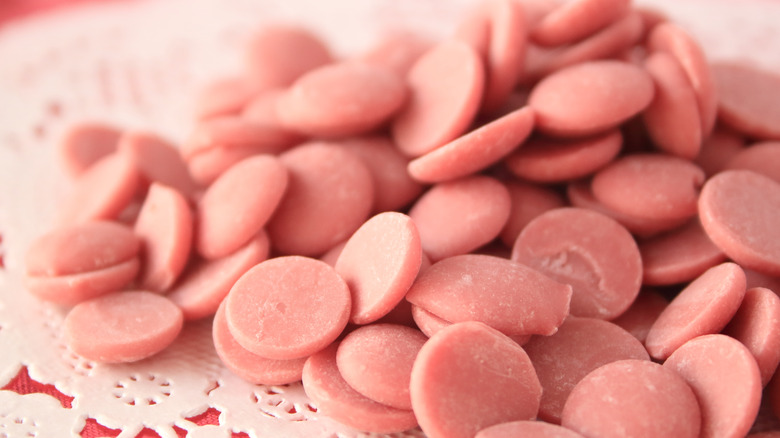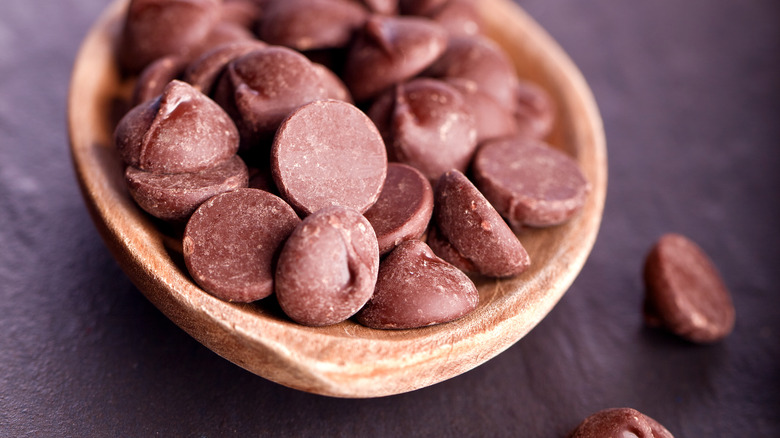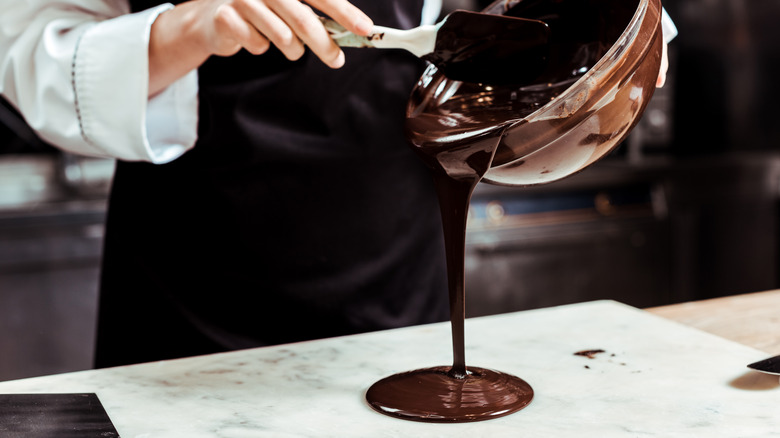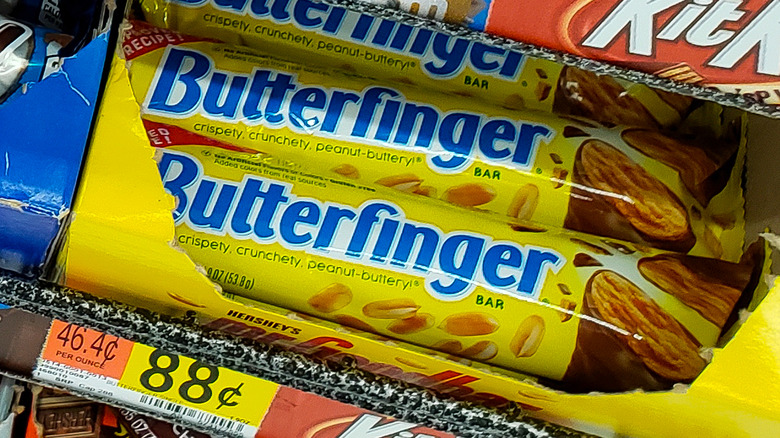12 Types Of Baking Chocolate And What Makes Them Unique
Popular opinion: chocolate might be the perfect food — and yes, we know we're not going out on much of a limb with this declaration. Sweet, bitter, and complex, chocolate has been the culinary object of desire of cultures around the world for millennia. In its highest-quality forms, chocolate can be one of the most stimulating, nutritious, and heart-healthy foods available. And, as many home cooks know, many types of chocolate are essential to baking.
To describe chocolate as divine gestures to its origins among indigenous civilizations in southern Mexico. According to the Smithsonian, both the Mayans and Aztecs combined chocolate with chiles and other ingredients and drank it as a ceremonial beverage during rituals and feast days. These cultures believed it had magical properties (a belief we also share). When cacao was exported from Mexico back to Europe, naturalists gave the plant the Latin name Theobroma cacao, meaning "food of the gods."
Today, high-quality chocolate is an essential ingredient in pastry kitchens worldwide. It comes in many forms, from cocoa-rich dark chocolate to sweet and creamy milk chocolate. White chocolate has no cocoa at all, while newcomer ruby chocolate is made using a rare cocoa bean varietal. Cacao nibs and cocoa butter, the building blocks of chocolate, are also being used by pastry chefs and chocolatiers in new and inventive ways. That said, if you're a baker, it is important to learn about all the different varieties and forms of chocolate used when baking, how they're made, and their best applications.
Cacao nibs
Making chocolate from cacao beans has remained fundamentally the same for centuries. The beans are fermented for several days, then dried and roasted. Then, the brittle outer shell is cracked open and separated using a process called winnowing, leaving behind only the cacao nibs, which are then processed into a liquid paste called chocolate liquor. From there, according to Dame Cacao, chocolate makers can separate the solids (cocoa powder), and fats (cocoa butter) for use in chocolate making, or the liquor can be molded into pure, unsweetened baking chocolate.
Cacao nibs are the fundamental ingredient in all forms of chocolate. They are delicious and highly nutritious on their own, with a bitter, nutty flavor reminiscent of cocoa powder. They're antioxidant powerhouses that pack a nutrient-rich punch. Cacao nibs have been making their way into everything from superfood smoothies and meal bars to fine dining menus worldwide.
Cacao nibs make a great addition to any chocolate dessert, bringing out complex toasty and bitter notes that offset the sweetness. As a garnish, they can add contrasting texture and crunch to creamy chocolate mousse or decadent chocolate tortes. To add some sweetness to cacao nibs before including them in a dessert, try candying them in caramelized sugar. Finally, candy makers love making crunchy chocolate-covered cacao nib clusters using couverture chocolate.
Cocoa butter
Cocoa butter is the versatile fat extracted from ground cacao nibs via hydraulic presses. It is one of the main ingredients in chocolate making and is used at different ratios depending on the type of chocolate produced. Unlike all other forms of chocolate that combine cocoa butter and cocoa solids derived from the cacao nib, white chocolate is made exclusively with cocoa butter without including cocoa solids.
According to Bakerpedia, cocoa butter is a stable fat, meaning that it remains solid at room temperature. It has a melting point just under human body temperature, which accounts for chocolate's pleasing ability to melt in your mouth. If you're a vegan baker or looking for a good alternative to dairy butter, home bakers can substitute cocoa butter at a 1:1 ratio. When using cocoa butter, you should know that the scent is much stronger than the taste, so if you're worried about plain baked goods having a chocolate odor, fear not. The flavor is mildly sweet but very subtle overall.
Cocoa butter isn't just used in baking and chocolate. As a cooking fat, cocoa butter is a heart-healthy replacement for coconut, avocado, or other cooking oils (via WebMD). It has a relatively high smoke point of 445 degrees F, making it great for high-heat cooking. It's also been shown to reduce harmful LDL cholesterol levels and boost beneficial HDL cholesterol levels.
Cocoa powder
Cocoa powder is the soul of chocolate, the product of extracting nearly all of the cocoa butter from cacao nibs. You'll find two kinds of cocoa powders in the baking aisle at your grocery store: natural cocoa powder (often labeled as unsweetened or baking cocoa powder) and Dutch-process cocoa powder. Natural cocoa powder tends to be lighter in color, fruitier, and more intensely flavored than Dutch-process cocoa (via The Washington Post).
The difference between the two goes beyond flavor and color. Dutch-process cocoa has been treated with an alkalizing solution like potassium carbonate to neutralize the acidity found in cacao nibs. On the other hand, natural cocoa is labeled as such because nothing has been done to strip it of its inherent acids. According to cookbook author Sally McKinney, Dutch-process cocoa works better with baking powder when used in a recipe. Baking soda requires an acid to react with to create leavening, so it works better with natural, acidic cocoa powder.
But don't worry: Dutch-process and natural cocoa powders are generally interchangeable when cooking with chocolate. If your recipe doesn't specify which type of cocoa powder it's calling for, it's usually okay to use what you have. Whatever style you choose, we recommend that you bloom your cocoa powder, an important step to getting the most flavor from this earthy ingredient.
Unsweetened chocolate
Unsweetened chocolate is chocolate in its purest form, composed of only two ingredients: cocoa solids and cocoa butter. Since cocoa beans have between a 51 to 55% fat content, unsweetened chocolate mirrors the ratio of fats to solids, per Baking Bites. Unsweetened chocolate is molded and hardened chocolate liquor.
Also known as baking chocolate, 100% dark chocolate, and bitter chocolate, you won't see unsweetened chocolate in the snack drawer. The cocoa percentage is important when it comes to baking and cooking. Most people find its flavor way too intense to eat alone, and it is far more bitter than the chocolate candy or other confections you can make. Instead, you'll find unsweetened chocolate recipes for cakes, brownies, and cookies. You can substitute unsweetened chocolate into recipes that call for other sweetened forms by adding more sugar to the mix.
That said, substituting unsweetened chocolate can be tricky and isn't recommended. If you must, use cocoa powder instead of unsweetened chocolate, mix it with an equal amount by weight of stable vegetable oil — ideally cocoa butter, but shortening can work in a pinch.
Dark chocolate
Dark chocolate is a catch-all term for chocolate containing more than 35% cocoa. Dark chocolate is often divided into bittersweet and semisweet categories, though the distinctions between the two are loose and usually determined by the individual manufacturer.
Dark chocolate is considered a superfood and rich in antioxidants and other nutritional benefits. According to the Harvard School of Public Health, dark chocolate contains compounds called flavanols that are associated with improved blood flow, lower blood pressure, and overall heart health. Healthline reports that dark chocolate is incredibly nutritious, boasting high levels of soluble fiber and vital minerals like iron, copper, and magnesium.
When shopping for chocolate to use in your recipes, it's important to pay more attention to the percentage of cocoa in the chocolate than what the manufacturer has decided to brand their product. Dark chocolate, bittersweet chocolate, and semisweet chocolate are more often used as marketing terms that can describe a wide range of products that contain anywhere from 35% to 90% cocoa. Instead, remember that the higher the percentage of cocoa in your chocolate, the less sugar and fat it will contain, and the more bitter and crumbly it will be.
Dark chocolate is the most versatile kind of chocolate to have in your pantry. It's used in everything from cakes and cookies to tortes, mousses, and ganache. Quality dark chocolate can be expensive, but it's one of those ingredients where you often get what you pay for.
Bittersweet & semisweet chocolate
Bittersweet and semisweet chocolate are simply different designations of dark chocolate. They are very similar in composition and flavor and can be used interchangeably in most recipes — the main difference between the two lies in the cocoa content. Bittersweet chocolate contains around 70% cocoa, about ten percent more than what's found in semisweet chocolate. The higher the percentage of cocoa in the chocolate, the lower the amount of other ingredients like cocoa butter and sugar.
While the differences are small, the amount of cocoa does affect characteristics like flavor, texture, and color. According to MasterClass, bittersweet chocolate tends to have a richer, more intense cocoa flavor, can be drier and more crumbly in texture due to its lower fat content, and is often darker in color. Sometimes, different manufacturers will brand all their chocolate products containing between 54% and 70% cocoa as bittersweet or dark, so depending on what you're baking, pay more attention to the percentage of cocoa than what name the product is given. This can affect everything from the notes of chocolate to the sweetness of your baked goods.
Bittersweet and semisweet chocolate are the most versatile and widely used chocolates in any baker's pantry and are sold in many forms, including chocolate bars, wafers, and chips. You'll find these types of chocolate in everything from chocolate chip cookies and cakes to elegant mousses and ganache.
Milk chocolate
Milk chocolate is the world's most popular chocolate. However, it didn't become a commercial success until the late 19th century when European manufacturers — candymakers and chocolate brands you still know and love, like Nestlé, Cadbury, and Lindt — came up with the process to make this sweet, creamy eating chocolate (via The Chocolate Society).
In order for it to be called milk chocolate, it must contain at least 12% milk solids and at least 10% cocoa. The smooth texture that milk chocolate is known for is the result of a process devised by Rudolf Lindt in 1879, called conching, where the mixture of cocoa solids, milk product, cocoa butter, and an emulsifier are scraped and ground back and forth for hours or even days. The longer this process takes, the more velvety and luxurious the chocolate bar will be (via Hotel Chocolat). As a product with higher sugar, milk chocolate will affect the sweetness of your goods, and that silky mouthfeel will also create a difference in texture as the chocolate melts easier.
Contemporary craft chocolatiers are taking milk chocolate to new levels by experimenting with the ratios of ingredients, increasing cocoa content, and playing with elements like temperature during the conching process to impart malty or caramel flavors to the chocolate. Cocoa Runners keeps a running list of the world's best milk chocolate and includes entrants from around the world. Many of them are producing what they're calling dark milk chocolate made with cocoa products sourced from premium cocoa bean producers.
White chocolate
Yes, white chocolate is actually chocolate, although it does not contain any of the cocoa solids found in other forms. Instead, in order to be legally classified as white chocolate, it must contain at least 20% cocoa butter and at least 19.5% milk solids and fats, according to Dame Cacao.
White chocolate's bad reputation likely comes from mass-market manufacturers who produce cheap, additive-filled confections, likely as a means of using up leftover cocoa butter. According to The Washington Post, these days, specialty chocolate makers around the world are highlighting excellent white chocolate products made with pure cocoa butter and premium dairy.
Despite its name, white chocolate doesn't always have to be white. French chocolatier, Valhrona, innovated Blond chocolate, a confection made by caramelizing the cocoa butter and milk products in white chocolate to bring out nutty, butterscotch characteristics. White chocolate superfan and pastry chef, David Lebovitz, shows us how exactly how that process can be done ourselves.
Because white chocolate has a mild, sweet, creamy flavor, it's a perfect foil for stronger ingredients. Candy makers will use white chocolate to make fruity or tart truffles. It's also great around the holidays when used in peppermint bark. And never forget the classic combo found in white chocolate macadamia nut cookies!
Ruby chocolate
Ruby chocolate debuted in 2017 when Swiss chocolatier Barry Callebaut announced the discovery of a "fourth chocolate" made from rare ruby cocoa beans grown in special climate conditions in Ecuador, Brazil, and the Ivory Coast.
While the process for making ruby chocolate remains a proprietary secret of the Barry Callebaut company, there are few clues we can glean from their public statements. First, the pink color of ruby chocolate is natural and is not the result of any color additives. According to the company's patent for ruby chocolate, the color is likely due to a mix of compounds within the cocoa beans, including an especially high quantity of pigmented polyphenols. In addition to other unique processes, the fermentation of this special cocoa bean may be as short as three days which helps to preserve its natural color.
Ruby chocolate is a wholly unique confection separate from white, milk, or dark chocolates. Food Network compares the flavor to white chocolate with rich berry undertones. With sweet raspberry and strawberry notes, ruby chocolate has a bright, tart finish.
Home bakers can use ruby chocolate in most applications where you'd find traditional dark chocolate. Use ruby chocolate chips in your cookies or when making blondies (pinkies?). It's perfect for a brighter take on a chocolate cheesecake, and the color is beautiful. For the ideal complement to its tart, fruity notes, use it to make ruby chocolate-covered strawberries. Callebaut has recipes for all these and more.
Chocolate chips, chunks, & wafers
Chocolate comes to us in many forms. Whether it's dark, milk, white, or ruby, you'll want to get the form of chocolate that best suits your application. According to the Gygi guide to chocolate, chocolate chips are made with less cocoa butter than chocolate bars or wafers and often contain stabilizers, so when they melt, they continue to hold their shape. That's why, when making chocolate chip pancakes, you end up with discreet little pockets of chocolate instead of messy chocolate goo cakes.
The historic candy origin of chocolate chips can be traced back to Swiss chocolatiers in the 1890s. Still, the small tidbits really gained popularity in the United States when, in 1939, Nestlé began selling the chocolate chips we know today to go with Ruth Wakefield's famous Toll House cookie recipe. As such, perhaps the most widely known baking use for this type of chocolate is in cookies.
Chocolate chunks (cut from chocolate bars) and chocolate wafers contain a higher percentage of cocoa butter than chocolate chips, allowing them to melt into pourable, gooey chocolate ideal for making chocolate ganache mousse or stirring into brownie batter. In baking, it's an important step to chop chocolate before melting.
Before melting chocolate, you should know that a double boiler can function better than a microwave to keep your confection stable. Put the chocolate in a heatproof bowl, place it over a pot of simmering water, and stir until you have smooth, glistening melted chocolate. The steam will heat the chocolate gently, preventing scorching or seizing.
Couverture chocolate
Couverture chocolate comes from the French word meaning to cover or blanket and is used by chocolatiers when making candy treats like truffles and bonbons. All four main types of chocolate come in couverture form, which is generally considered the highest quality chocolate for making candy.
Commonly referred to simply as couverture, what sets this chocolate type apart from others is its high content of cocoa butter — it needs to contain at least 31% cocoa butter to qualify (via readcacao). The higher ratio of cocoa butter allows the chocolate to melt easier and more uniformly. When the fat-rich chocolate is tempered, the result is a glossy finish and a satisfying snap.
Tempering is the process of heating, cooling, and reheating your chocolate to precise temperature ranges to manipulate the fat molecules in cocoa butter, giving you the glossy, snappy texture you'll find with chocolate-covered strawberries or filled truffle candies.
To temper chocolate, you'll need a thermometer and a double boiler. Melt the chocolate, stirring regularly, and bring it to 110 degrees Fahrenheit for milk or white chocolate and no more than 120 degrees F for dark chocolate. Remove couverture from the heat and stir continuously until it reaches 84 degrees F, which can take up to 15 minutes. Then, place it back over the double boiler and bring it back up to 89 degrees F, which is the temperature it needs to be to work with (via Handle the Heat).
Compound chocolate
Compound chocolate — also known as compound coating in Europe (because it doesn't legally qualify as chocolate), is the cheaper, lower quality step-cousin of couverture chocolate. Instead of using cocoa butter, compound chocolate will use other vegetable oils and additives to create the mass market chocolate candy you find for sale in supermarket checkout lanes and convenience stores. Using fats like palm oil or soybean oil not only affects the flavor and the price of chocolate but also changes the way it behaves, making it a poor substitute when recipes call for couverture (via Dame Cacao).
For home chocolatiers, the main appeal of using compound chocolate over couverture is that it's easier to work with. Compound chocolate does not need to be tempered to create an attractive, glossy coating. What you gain in ease of use over couverture, however, you sacrifice in the richness of flavor and smoothness of texture (via Gygi).
